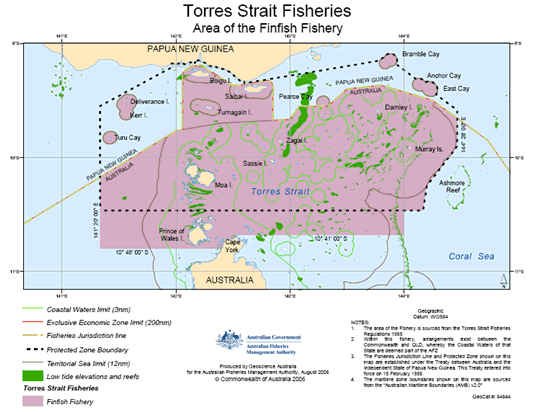About the Torres Strait Finfish (Reef Line) Fishery
The Torres Strait Finfish (Reef Line) Fishery is a multi-species fishery with a range of reef fish being targeted. The fishery focuses primarily on the highly valued coral trout (Plectropomus spp.), mixed reef fish (Lutjanus spp. and Lethrinus spp.) and numerous species of rock cods (Epinephelus spp.).
Finfish are generally taken by hand lines and since December 2005, the use of nets for commercial fishing has been banned throughout the Torres Strait Protected Zone (TSPZ) and the outside but near area.
During 2007–2008 a voluntary buy-back of all non-Traditional Inhabitant licenses was undertaken in the Torres Strait Reef Line Fishery. This transferred all catch entitlements to the Traditional Inhabitant sector. These entitlements are held in trust by the Torres Strait Regional Authority (TSRA).
Entry into the fishery is limited to Traditional Inhabitants to maximise their economic development and employment opportunities. Non-Traditional Inhabitant fishers can still participate in the fishery by leasing a temporary licence administered by the TSRA. Leasing arrangements include agreed conditions for fishing in the fishery including a Total Allowable Catch (TAC) and area closures. Catch entitlements are also held aside to provide for catch-sharing arrangements for Papua New Guinea if required.
A Finfish Resource Assessment Group and Finfish Working Group have been established to provide advice to the PZJA on issue related to the Reef Line Fishery. See PZJA Committees for more information.
Fishery Map

Map showing the area of the Torres Strait Finfish Fishery (2006)
The objectives for the Torres Strait Finfish (Reef Line) Fishery have been developed in conjunction with the objectives of the Torres Strait Fisheries Act 1984 and the Torres Strait Treaty.
The objectives, outlined under the Torres Strait Finfish Fishery Management Plan 2013, are:
- to acknowledge and protect the traditional way of life and livelihood of traditional inhabitants, including their rights in relation to traditional fishing for finfish
- to ensure that harvest levels are at, or below, levels that maintain biologically viable stocks of target and non-target species
- to provide for the use and conservation of Torres Strait finfish resources in a way that minimises impact on the marine environment
- to optimise economic viability of the fishery
- to provide for optimal utilisation, cooperative management, and for catch sharing to occur with Papua New Guinea.
The Torres Strait Finfish Fishery Management Plan 2013 and the Torres Strait Fisheries (Finfish) Management Instrument 2020 outline management arrangements for the fishery.
Rules include:
- limits on possession of fish species
- minimum and/or maximum length requirements
- prohibition on shark finning
- prohibition of using fishing methods other than a bait net or line fishing
- prohibition of possessing no-take species
- permanent closures
- seasonal closures for Barramundi.
For further information, please consult the Torres Strait Fisheries (Finfish) Management Instrument 2020.
The Torres Strait Finfish Fishery Management Plan 2013 is in force and includes arrangements for the Spanish mackerel and reef-line sectors of the fishery.
The Australian Bureau of Agricultural and Resource Economics (ABARES) produces annual Fishery Status Reports that independently evaluate the biological and economic status of fish stocks managed solely or jointly by the Australian Government.
The Torres Strait Finfish (Reef Line) Fishery was strategically assessed under the Environment Protection and Biodiversity Conservation Act 1999 during 2023 and was reaccredited as a Wildlife Trade Operation in late October 2023. Information about the Torres Strait Finfish Fishery strategic assessment can be found on the Department of Climate Change, Energy, the Environment and Water website.